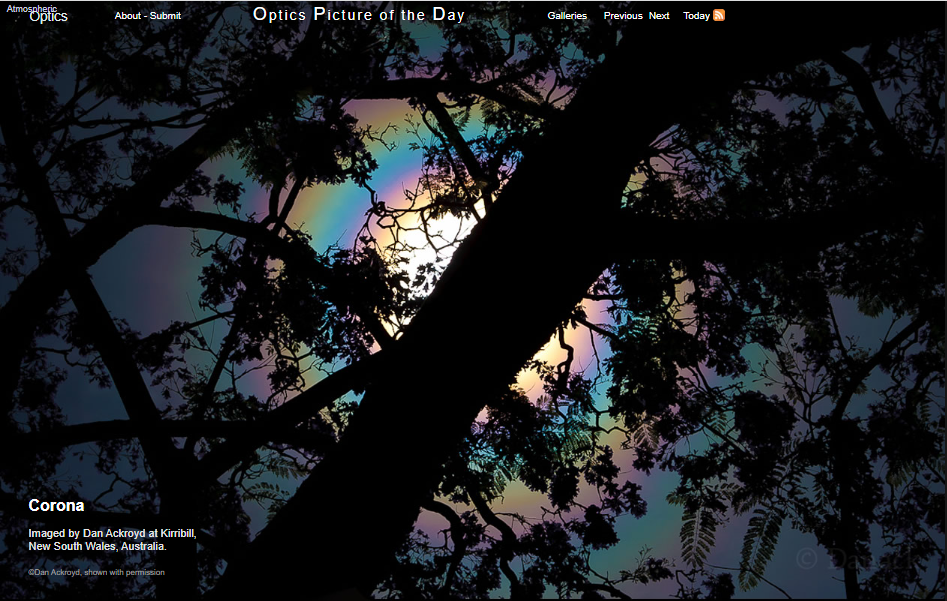Corona - OPOD
Corona - An Optical Phenomenon
Coronas are fascinating optical phenomena that occur when light is diffracted through very small particles in the atmosphere. These particles are typically water droplets or ice crystals suspended in the air. The result is a beautiful display of rainbow colors encircling the Sun or Moon.
Dan Ackroyd, an avid photographer, captured an incredible corona image during a stroll in Kirribilli, New South Wales, Australia. He noticed something unusual about the Sun's appearance, with rainbow hues surrounding it. Despite the Sun's brightness making it difficult to observe clearly, he managed to take a few photographs, strategically positioning a tree trunk to shield his camera from excessive light.
Upon reviewing the images at home, Ackroyd realized he had captured a corona. The corona in his photograph was formed due to the diffraction of light by the tiny water droplets present in the atmosphere. These droplets act as miniature prisms, bending and dispersing the light waves, resulting in the circular array of colors.
One intriguing aspect of coronas is that their size can provide insights into the dimensions of the water droplets causing them. By measuring the angular size of the corona in the photograph, Ackroyd was able to estimate the size of the water droplets responsible for its formation. This relationship between corona size and droplet size has been studied extensively by scientists and has led to the development of tools and methods for calculating droplet dimensions based on corona observations.
The corona image captured by Ackroyd serves as a testament to the intricate beauty of atmospheric optics. It showcases nature's ability to create mesmerizing displays by manipulating light and particles in the atmosphere. These phenomena not only captivate photographers and enthusiasts but also provide valuable data for scientific research.
Coronas are not limited to sunlight alone; they can also be observed around the Moon during certain atmospheric conditions. In fact, lunar coronas are often larger and more vibrant due to the Moon's greater distance from Earth. The presence of ice crystals in the upper atmosphere can give rise to stunning lunar coronas, with the moonlight diffracting and producing a similar colorful halo.
The study of coronas and other atmospheric optics phenomena is crucial for understanding the behavior of light in the atmosphere and its interaction with particles. Scientists and researchers employ various instruments and techniques to study these optical phenomena, including spectrometers, polarimeters, and high-resolution cameras. Their observations contribute to our knowledge of atmospheric physics, climate modeling, and weather forecasting.
In conclusion, coronas are awe-inspiring optical phenomena caused by the diffraction of light through tiny particles in the atmosphere, such as water droplets or ice crystals. These phenomena create mesmerizing displays of rainbow colors encircling the Sun or Moon. Through the diligent work of photographers like Dan Ackroyd and scientific research, we gain a deeper understanding of the intricate beauty and underlying physics behind these atmospheric optics phenomena. So, next time you catch a glimpse of a corona, take a moment to appreciate the wonders of nature's light show in the sky.

Corona
Imaged by Dan Ackroyd at Kirribill, New South Wales, Australia.
©Dan Ackroyd, shown with permission

"One day in Kirribilli I went for a little wander with my camera, to see what I could see and maybe take a photo of it.
After not having walked very far I noticed out of the corner of my eye that the Sun appeared a bit unusual. I couldn't see it very clearly, as the Sun was so bright, but it seemed that there were rainbow colours around the Sun.
I took just a couple of pictures, trying to get a good tree trunk in front of the Sun to prevent it from burning my camera (or eyes) too much. Because I'd hurt my eyes a bit by looking at the Sun (I recommend not doing that) I only took a couple of shots, and couldn't really see what the picture looked like on the little camera screen.
When I got home I realised that I'd taken a picture of something a bit unusual. It's a corona which is formed when light is diffracted through very small particles, almost certainly water droplets in this case.
It's possible to figure out what the size of the water droplets is from the angular size of the corona they produce, so I made this web page to do that. The full-size image can be seen on my Flickr page."
Note: this article has been automatically converted from the old site and may not appear as intended. You can find the original article here.
Reference Atmospheric Optics
If you use any of the definitions, information, or data presented on Atmospheric Optics, please copy the link or reference below to properly credit us as the reference source. Thank you!
-
<a href="https://atoptics.co.uk/blog/corona-opod/">Corona - OPOD</a>
-
"Corona - OPOD". Atmospheric Optics. Accessed on November 26, 2024. https://atoptics.co.uk/blog/corona-opod/.
-
"Corona - OPOD". Atmospheric Optics, https://atoptics.co.uk/blog/corona-opod/. Accessed 26 November, 2024
-
Corona - OPOD. Atmospheric Optics. Retrieved from https://atoptics.co.uk/blog/corona-opod/.